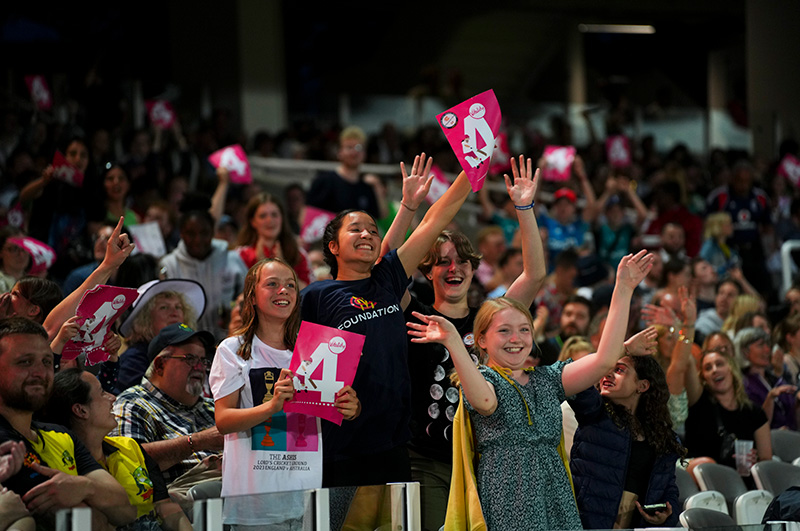Test cricket popularity as strong as ever says MCC World Cricket committee following MCC survey
read story
Come here to find all the information you need to help you plan your visit to the Home of Cricket, the latest news from the Ground and to book your event.

We’ve got a wide variety of formats covered with an exciting line up of matches to get your cricket fix.
Whether you like red or white ball, domestic or international, or men’s or women’s cricket, Lord’s will have the perfect cricket experience for you, your family and friends.

Marylebone Cricket Club is the world’s most active cricket club, the owner of Lord’s Ground and the guardian of the Laws of the game. Find out more about the history of MCC, our work in the Community and the famous Lord's Museum.
FIND OUT MORE

Step closer. Your new digital platform at the Home of Cricket.
Subscribe now for early access to selected international matches, exclusive content, coaching masterclasses and many more discounts and offers.
Your access to Lord's like never before.

Marylebone Cricket Club is one of the World's most active Cricket Clubs, the owner of Lord's Ground and the Guardian of the Laws and Spirit of the Game.
With around 200 full time staff members covering a wide range of sectors - from IT to Chefs to Pavilion Stewards - there is a role at the Home of Cricket for everyone.

Posted: 12 March 2019
David Richardson, outgoing Chief Executive Officer of the International Cricket Council, provided an update from ICC, and Alex Marshall, General Manager of the ICC Anti-Corruption Unit, presented to the Committee on Corruption in Cricket.
The World Cricket committee has already shared its unanimous support for the inclusion of a women’s T20 competition in the next Commonwealth Games, to be held in Birmingham, England, in 2022. The committee also announced the results of its MCC Test Cricket survey, following over 13,000 responders from more than 100 countries taking part in the survey, with Test cricket coming out as the format that interest fans most.
Further areas discussed were as follows:
The World Test Championship begins after the ICC Men’s Cricket World Cup. The MCC World Cricket committee felt that it would benefit the Championship for a standard ball to be used in these matches, except for those played as day/night matches. It would be for the ICC to choose which ball is most suitable, with the committee stressing that the balance between bat and ball is crucial.
Trials of the use of different balls have been taking place in different countries at first class level. Currently, the Dukes ball is used for Tests in England and the West Indies, the SG ball is used in India, and the Kookaburra is used in all other countries. For day/night Tests, the pink Kookaburra has been the ball of choice, whilst all One Day International and T20 International cricket uses the white Kookaburra ball.
The committee felt that the World Test Championship provided the perfect opportunity to introduce this suggestion.
The MCC World Cricket committee believes that a number of measures should be investigated, to speed up the pace of play in Test matches. The committee has historically been concerned about the pace of play and this was highlighted as a problem by the respondents in MCC’s recent Test Cricket survey.
When asked what the main barriers were for attending Test Cricket, 25% of fans from England, Australia, New Zealand & South Africa mentioned slow over rates. In those countries, where spinners bowl fewer overs, the full 90 overs are sometimes not bowled in a day, even with the extra 30 minutes. ICC’s statistics from May 2018 showed that over rates in the last year were the lowest in the eleven years that they had been measured, at 13.77 per hour.
Whilst the Decision Review System (DRS) was partly responsible for the delays, the committee felt that a series of measures should be introduced to help to speed up the game. More urgency needed to be shown by the players, who should play a brand of “ready-cricket” with more forward planning. Specific recommendations include:
The MCC World Cricket committee recommends that Free Hits should be introduced after No balls in Test matches. The system is used in the white-ball formats and the added deterrent results in there being fewer No balls than in Tests. For example, England recently had a spell of 45 ODIs without bowling a No ball, yet they bowled eleven in the three Test series against the West Indies. The system would not only be exciting for crowds when there was a Free Hit, but also it would help to speed up over rates, if fewer No balls are bowled.
The MCC World Cricket committee has asked MCC to carry out trials of the various ideas aimed at improving the spectacle of Test Cricket that were discussed at the recent meeting in Bengaluru on the 8th and 9th March. MCC will review opportunities over the coming months where this will be possible and these will include:
The next MCC World Cricket committee meeting will take place on the 11th and 12th August at Lords.